Architecture Of Database System
Author: rainbow
Published in: Information Technology
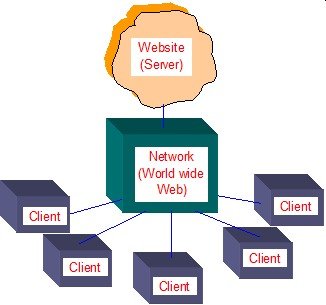
Introduction
The architecture of the database of the system is dependent on the various types of database systems. The database contains the data or information in the formatted form. The data is stored on the various field in the database in the form of table. Any database can contain number of tables and there can be number of database having different table.
The database system has different method of the storage of databases and tables. There are different methods used for storing and accessing the database and connecting the tables in the database. The structure of database is created then there are number of data values which can be stored into the structure.
In this article we want to study the various types of data bases and data bae models being used for storing of data.
Types of databases
Any type of database system is influence by architecture of computer system. There are various systems used in modern database structures,
- Centralize system
- Client server system
- Parallel network system
- Distributed system
- Web enabled system
These systems are explained as below,
- Centralize system
The centralize system works on single computer without any interaction with other computer systems. This is a single user database system used on PC’s or mainframe computer. The system has single CPU and one or more memory devices but operating system support only one user. The databases designed for such systems are such that they can have one query on one processor.
- Client-server system
The client server system is the system where the complete data is stored on the server and various clients can access the server at same time and can operate on the database. It may be possible that a single client can access multiple servers and extract data from various servers.
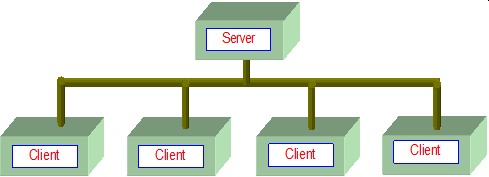
Fig. 1.1
Fig. 1.1 shows the single server and multiple client model in which the database on server can be access by client.
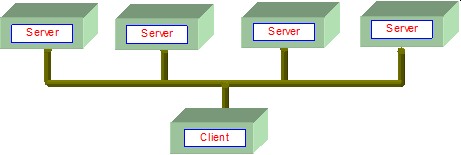
Fig. 1.2
Fig. 1.2 shows multiple servers connected to single client. In this case the client can access databases on different servers.
2. Parallel system
In this system the computers are connected to each other by inter connected network system where multiple CPU’s and memory devices are in parallel and variety of operation on database can be carried out by different processors.

Fig. 1.3
3. Distributed system
In the distributed system is database is shared on various computers and communications occurs through the network system or telephone lines. The computers are located at different places and the data can be transferred through the WAN or wireless network system.
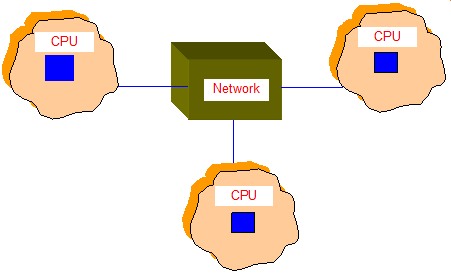
Fig. 1.4
5. Web enabled database system
The web enabled database system is a system used on world wide web. The web pages are generated by using html language and they are used in e-commerce for transaction processing on databases. The databases are stored on the web site and they can be access by the client who visit the web site and then information can be obtained by him by filling a web page on the site. The most popular languages for the web are Java and SQL calls can be made by Java program using Java database connectivity (JDBC). The web sites act as server and various clients and access the site and acquire the desired information.
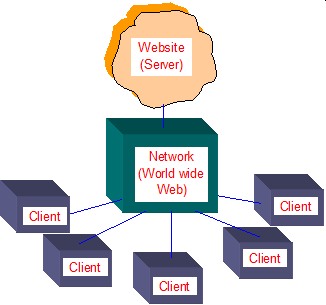
Fig. 1.5
Database Models
It is a method of organizing data which represents the logical relationships among the data elements in the database. There are three types of models
1. Hierarchical database
2. Network database
3. Relational database.
Hierarchical Data base
In this model, main database is connected to other databases arranged at the lower level.
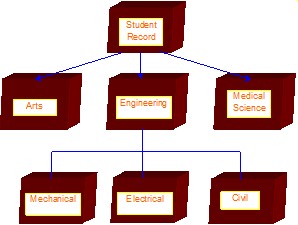
Fig. 1.6
Fig. 1.6 show hierarchical model of data bases in which students as connected to three other databases as Arts, Engineering and Medial Science. The Engineering database is connected to three other databases as Mechanical, Electrical and Civil.
Network databases
In this case, the main database is connected to number of databases in a network, where all other databases can be connected to the main database.Fig.1.7 shows the data base for the stores record in which the stores records are maintained using the network data base.
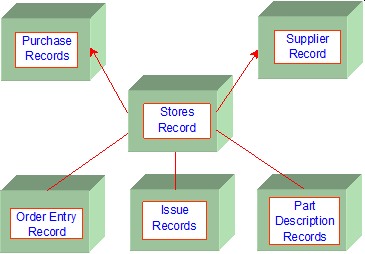
Fig. 1.7
Relational databases
The database which are inter related to each other by relational data bases.Fig.1.8 shows the employee’s salary system or payroll system using relational data base.

Fig. 1.8
Fig.1.8 shows relational data base system of salary of employees and their information records.
Recent development in data bases
There are new varieties of databases being used for storing data and information in better formatted form. These are
- Distributed databases
- Client server data bases
- Object oriented data bases
- Multi-media data bases
1. Distributed databases
It is a database distributed over the single or multi-vendor computer network located in different geographic areas. These are banking system, corporate companies, payroll system etc.
2. Client-Server databases
These data bases are used in the networking system. The network user can initiate several client and the server provide database which can be accessed by different clients
3. Object oriented databases
These databases are the databases which provide hiding of data values and allows modification of data members by assisting program. Some of the data values are protected and some of the values are easily modified.
4. Multi-media databases
These data bases can handle complex data objects like scanned images, map, drawing, pictures etc. The object-oriented programming technology can handle complex databases.
Data Base administrator (DBA)
The operation on the database is done by using the administrator which is software which allows for administration of a database. The database administration system is a block of code loaded from the hard disc for operation of the system.
The DBA allows for
1. Updating the database
2. Retrieving information from the database
3. Accepting query language commands
4. Providing security and data integrity specifications
5. Enforcing transactions
6. Managing data sharing
7. Providing user made and ready made functions
Conclusions:
The architecture of data base system and types of data base to be used depends on the situation and conditions in which the system functions. The relational database system is normally used in large number of database operations.
Article Comments
Similar Articles
Articles Search
Sponsor
There are zero sub-categories in this parent category.
There are zero sub-categories in this parent category.
There are zero sub-categories in this parent category.
















